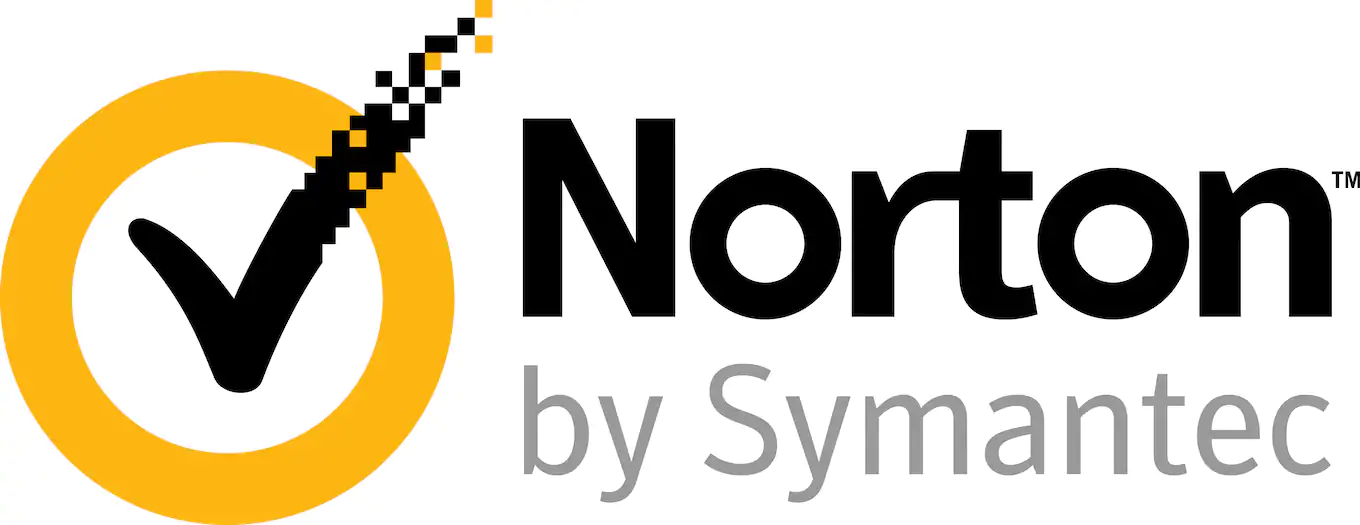Panda Security Review
The Panda Security Suite is a well-known free antivirus tool. In this Panda review, we'll be talking a look at this Panda Dome and deciding whether its any good. We'll spoil our results a little and tell you that while the free plan is good, we wouldn't recommend you pay for it.
Panda Security, or, more accurately, Panda Dome, is a feature-packed antivirus that can’t quite contend on our best antivirus software list. It comes with a high price tag, too, which is difficult to swallow given the poor user experience.
In this Panda Security review, we’ll discuss the interface and how it impacts the overall experience. We’ll go over features, pricing, user-friendliness, protection and support before giving our verdict.
We like Panda’s level of features and support options, but not its price or interface. You’re paying more than you would for other protection packages for features that don’t impress. Lab results and a generous free option may be enough to warrant a sign-up, though.
Alternatives for Panda Security Review
- 1$1.88 / month(All Plans)
- 2$2.50 / month(All Plans)
- 3$3.12 / month(All Plans)
Strengths & Weaknesses
Pros:
- Lots of features
- Many support options
- Excellent lab results
- Scans light on resources
Cons:
- Clunky interface
- Expensive
Features
If you want features, Panda has you covered, as long as you’re paying a premium. As we’ll discuss in the next section, Panda is expensive, but it comes with a dense enough feature set to justify the price.
All plans come with Panda Smart Shopping. The Chrome extension performs a familiar antivirus function, protecting you against fraudulent pages and phishing schemes, but it also shows you deals for products you’re shopping for, coupons around the web and verified eBay merchants.
There’s a separate extension called Panda Safe Web. It’s a surprisingly dense feature, bundling a tracker blocker, ad blocker and website health monitor into one extension. The catch is that you have to use Panda’s search engine, which is just a re-skinned Yahoo. Disabling the search engine and changing your homepage will also disable and remove the extension.
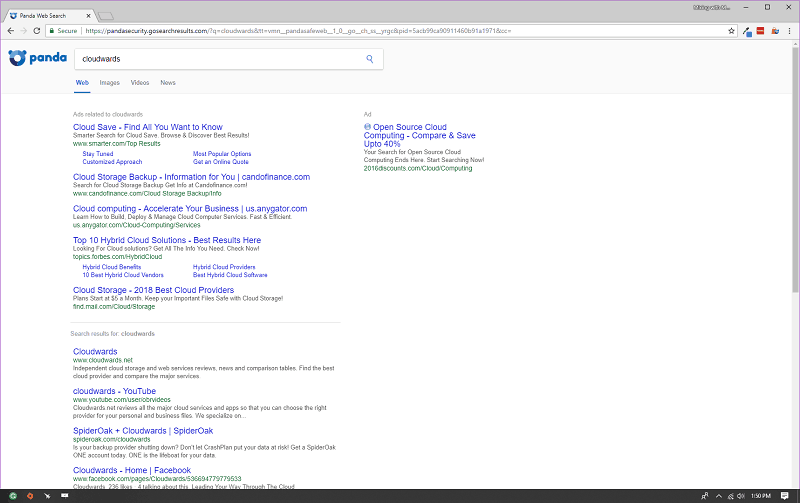
That’s a shame because we like Safe Web. It offers a lot of features to speed up your browser experience while keeping you safe. We don’t like antiviruses strong-arming us to install their search engine, though, so Safe Web will, unfortunately, remain off.
Utility features, including a file shredder, file encryptor and PC tune-up, are welcome additions. The tune-up can defrag your hard drives, free space by clearing temporary application files and manage your start-up files. It’s only available to Complete subscribers, though, and we’re not keen on spending money for functions Windows has built-in.
The file shredder is nice, though. It’s a common feature among premium antiviruses that removes all data tied to a file when you delete it. Normally, when you remove a file, the data is left on your hard drive until you overwrite it, opening up the possibility of using forensic tools to reconstruct it.
Panda’s Premium Features
Those paying the high price of Complete or Premium get many additional features. The first is a password manager, or, more accurately, a copy of Password Depot 11, which we didn’t rate well in our Password Depot review.
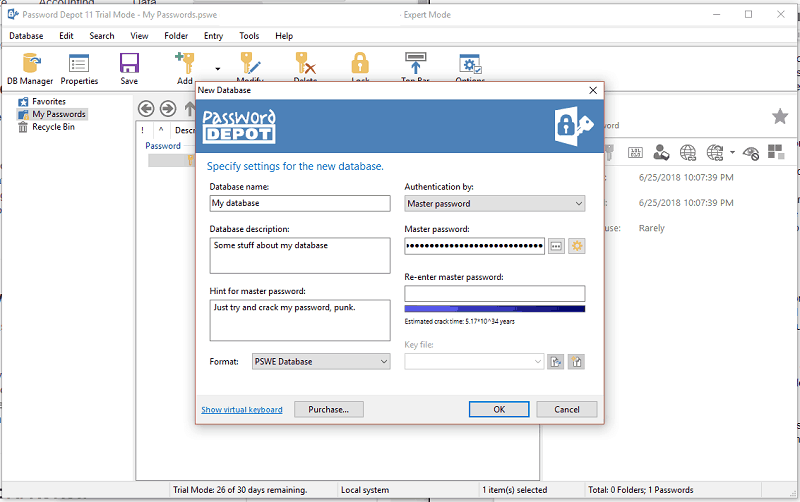
It couldn’t make our best password manager list, either, because of its difficult-to-use interface. A nice inclusion, but we recommend you get Dashlane instead (read our Dashlane review).
Panda includes a virtual private network, as well, which, again, comes from a third party. Hotspot Shield provides the VPN service. It has a worrisome privacy policy that allows it to collect your IP address and share it with any government agency that requests it. We didn’t like other areas of the service, either, which you can read about in our Hotspot Shield review.
More confusing is that Hotspot Shield claims it has a no-logs policy. For a VPN provider that truly doesn’t keep logs, make sure to check out our ExpressVPN review.
Panda has no shortage of features, but the ones included aren’t good. This antivirus is best ordered a la carte, skipping the VPN and password manager for more powerful and user-friendly options.
Panda Security Features Overview
| Features | |
|---|---|
| Password manager | |
| File shredder | |
| Multi-OS support | |
| Parental control | |
| Disk cleanup | |
| VPN | |
| Profiles | |
| Ransomware protection | |
| Webcam protection | |
| Real-time monitoring | |
| Secure browser | |
| Download protection | |
| Phishing protection | |
| Firewall | |
| Windows | |
| macOS | |
| Linux | |
| Android | |
| iOS | |
| Desktop UI | |
| Mobile application | |
| Browser extension | |
| Help Center | |
| Forum | |
| Live Chat | |
| Phone | |
| 24/7 Support | |
| Video Tutorial | |
| Free Plan |
Pricing
- For 1 device Antivirus with Firewall VPN with 150 MB/day limit for secure browsing Wi-Fi protection Secure online shopping Email checker Dark Web Scanner
- For 1 device Everything in Essential plus: Ransomware protection Parental Control
- For 1 device Everything in Advance plus: Cleanup: PC optimization Password Manager
- For 1 device Everything in Complete plus: Dark Web Monitor Update Manager Premium VPN Total Care: 24/7 technical support
Panda’s approach to pricing is different from other antiviruses. Instead of charging more for a larger list of supported operating systems and number of devices, all plans support Windows, macOS and Android and come with support from one to unlimited devices.
Even so, for the features you’re getting, prices are good. Essential gets you basic protection with an antivirus, firewall and secure browsing for the same price as Norton Basic (read our Norton Security review). Panda is a more versatile choice, though, as it comes with support for Android and macOS.
Advanced has more features in the form of ransomware protection and parental controls. We like ransomware protection, but, for the premium you’re paying on multiple devices, parental controls don’t make much sense.
Complete is the sweet spot. Support for five devices is still under $100 and it comes with the features of Advanced, along with a password manager and device tune-up. It’s expensive, but has all the features that we’d expect from a “complete” antivirus.
Premium is just that: premium. You’re paying a lot more for extras, including a VPN, cloud storage and premium support. It’s more expensive than McAfee Total Protection (read our McAfee Total Protection review), but comes with more features. Overall, we recommend checking out our best VPN and best cloud storage providers to piece together a protection plan.
Panda has pricing available per month with no commitment. As is expected, annual rates have a larger discount, but we like that Panda gives you the option to pay as you go, unlike many other antiviruses.
Rates for a single device are already high, making a multi-device plan far more expensive than the competition. Panda packs in the features to back up the rate, but that doesn’t fix the large bill.
Panda offers a free antivirus for Windows and Android that provides relief from the pricing. For example, you could purchase a single-user plan for your desktop and still get protection for your mobile device with a free plan.
That’s what we recommend for Panda. It’s good at both extremes, either for a single user with a couple of devices or a large family that needs to protect everything. There are cheaper options, though.
User Friendliness
Panda Security is a lightweight package, on the level of Webroot, with only a 2MB installer (read our Webroot SecureAnywhere review). Installation time was quick, too, the as the whole process finished in under a minute.
If you don’t want Panda messing with your homepage and search engine settings, make sure you uncheck those boxes before the application installs.
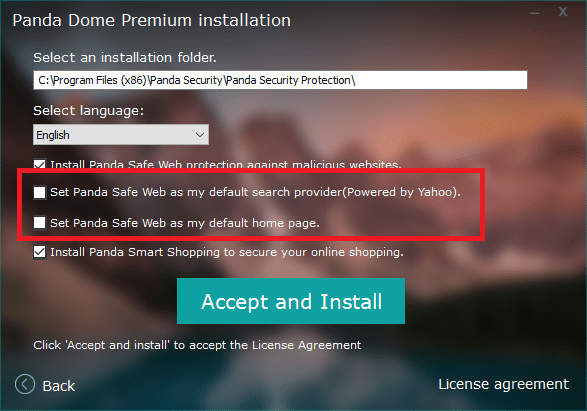
Once the installation is done, Panda will run a full scan, setting a baseline for your system. The scan is run in the background and, from what we can tell, is slower than a normal scan. We’re assuming this is a lightweight check, so you can still use your machine. Additional scans can be carried out with the magnifying glass icon at the bottom of the interface.
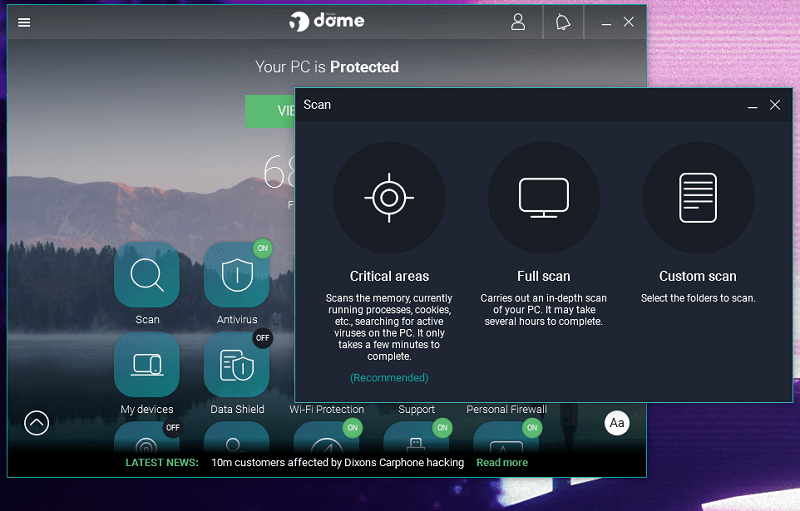
There are three scan modes: full, custom and what Panda calls “critical areas.” The last is like a quick scan, going through memory, running processes, cookies, etc. to search for active viruses on your machine.
Scans don’t require many resources, either. As with all antiviruses, your drive usage will be pinned, but we only noticed a 5 to 7 percent increase in CPU utilization over idle.
Outside of scanning, things get messy. Panda has a dense interface that’s deceptively simple when you first load it. The main screen shows you the number of files scanned, your status and five icons. There’s also an annoying news toolbar at the bottom that Panda allows you turn off in settings.
When we tried that, though, the toolbar remained.
Scrolling down reveals more icons — 23 on Premium Security. Each icon represents the different components of your antivirus package, everything from the file shredder to the password manager. There are other utility icons, such as support and products, as well.
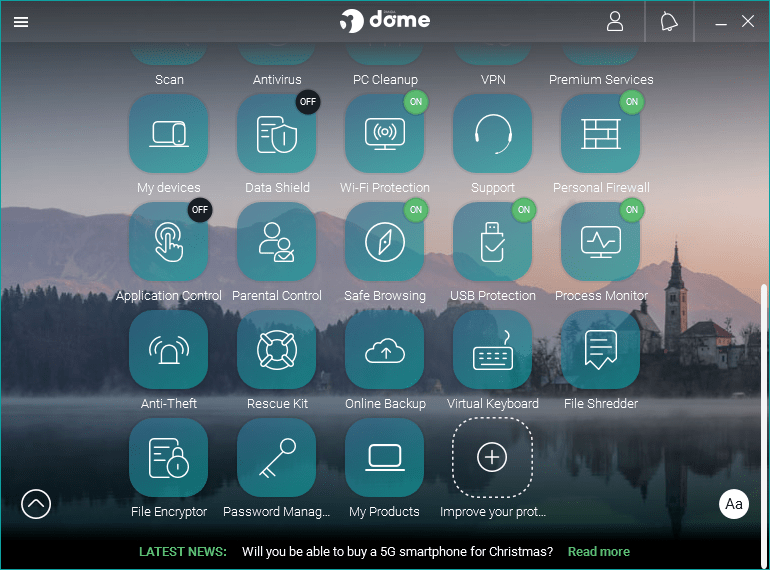
Those last two settings can be accessed by clicking the three dash icons in the top left of the UI. That menu is a more familiar control area for antiviruses, where you can manage your devices, products and settings.
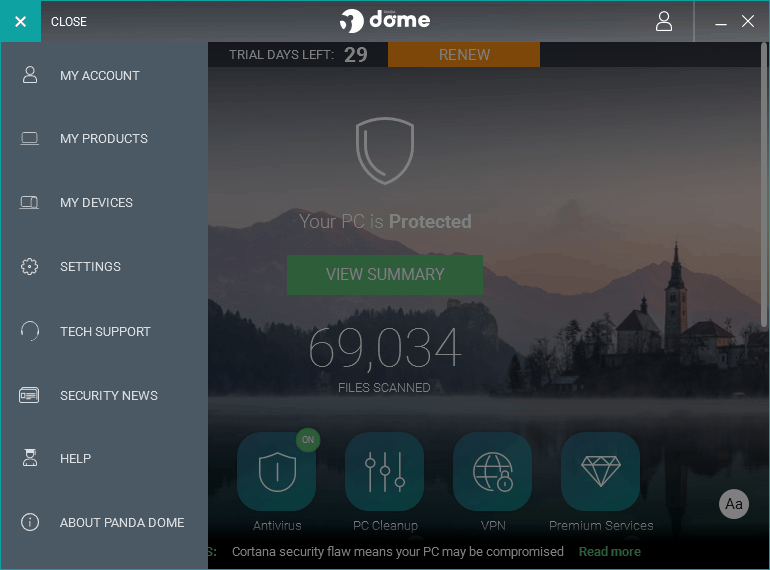
We don’t like the mingling of the two. If the settings menu for your devices is in the left menu, then it shouldn’t be an icon. Breaking up the interface between desktop and browser would clear workload on the application and make for a cleaner overall experience.
What results is a complex interface that tries too hard to look modern. There’s a lot of power there, but not the usability to make sense of it. Plus, the interface slows to a crawl because of all the options. Scrolling is choppy and responsive features respond behind clicks.
That doesn’t make Panda broken, though. The interface still functions and it functions well, at that. As long as you can get passed the choppy performance and learning curve, you’ll find one of the most dense antivirus interfaces on the market.
Protection
We use hands-on testing and lab results to gauge how well an antivirus performs. Our personal testing uses established antivirus testing tools, not in-the-wild samples, so we put more weight on lab results when we make our score.
The Anti-Malware Standards Organization’s feature setting check for desktop antiviruses was the first batch of tests we ran. Panda blocked all files from downloading, but not from generating download files. Overall, the built-in protection of Chrome and Internet Explorer seemed more effective in these tests.
We re-ran the tests in Internet Explorer with the Panda Security Toolbar installed. Protection improved, but performance shrugged. The browser slowed to a crawl with the toolbar enabled, which AV-Test noticed in its most recent evaluation, as well.
Wicar had strange results. Panda didn’t block any of the 13 tests, but none of the exploits were successful, either. If a test is successful, the browser closes and calc.exe opens on Windows. That didn’t happen, but a blank webpage opened instead.
That means the vulnerability trigger for a specific exploit was not specific enough for the antivirus to detect. A blank window generally indicates that the exploit was not detected or prevented, though no malicious files carried through to our test machine.
Despite odd performance, we’re going to lean on the labs and say that Panda was successful in our testing. Pages loaded and files began downloading, but nothing actually made it on to our machine.
AV-Test’s last evaluation of Panda was December 2017. It was 100 percent effective against zero-day malware and malware discovered in the wild that month. The industry average at the time was 99.5 percent, putting Panda a notch above.
It scored 15.5 out of a possible 18 points because of machine slowdowns, though. AV-Test observed a 51 percent decrease in performance versus a 16 percent industry average when launching popular applications. Even worse, it found a 77 percent performance hit when installing frequently used applications.
What’s odd about AV-Test’s findings is that there is a significant delta between a standard PC and high-end PC. Copying files, for example, saw an 8 percent slow down on a standard rig and a 55 percent slow down on a high-end one.
AV-Test runs performance numbers several times, throwing out faulty results. We’re not sure why there’s such a difference between two systems performing the same task, but we’re confident with AV-Test’s findings.
AV-Comparatives was more forgiving, awarding Panda an advanced rating, the second highest one, in performance. Protection tests were good, as well, blocking 98.7 percent of the samples. Overall, it was awarded two out of three stars.
Panda has had slip-ups during AV-Comparatives’s testing, though.. May 2018 and November 2014 both came with a protection rate of below 95 percent, meaning the antivirus failed for those months.
MRG Effitas found Panda secure. It was awarded a Level 2 certification in the Q1 2018 testing, blocking at least 98 percent of threats. Webroot also passed with this certification where Trend Micro Maximum (read our Trend Micro Antivirus+ Security review) failed.
Overall, protection is good, but not great. Panda consistently has protection rates between 95 and 99 percent, but it’s weakened by poor performance on high-end hardware. If security is your main focus, we recommend Bitdefender (read our Bitdefender Antivirus review).
Support
Panda has every avenue of support we could ask for from an antivirus. You get phone, live chat and email contacts, along with a forum and knowledgebase. Finding all of those areas is a hassle, though.
The main support page has numbers for standard and premium phone support, as well as a link to the email form. Scrolling down, you’ll find the knowledgebase, which is broken up by product.

The floating bar at the bottom of the page shows quick links to live chat, the forum and the support Twitter. It’s easy enough to find those options, but we can’t figure out why Panda wants to separate them. Putting live chat next to phone and email support is more logical and would help the support page feel less cluttered.
Things get better once you find what you’re looking for. Knowledgebase articles are detailed and filled with screenshots. Panda has articles for each product split by category, too, making navigation through the knowledgebase simple.
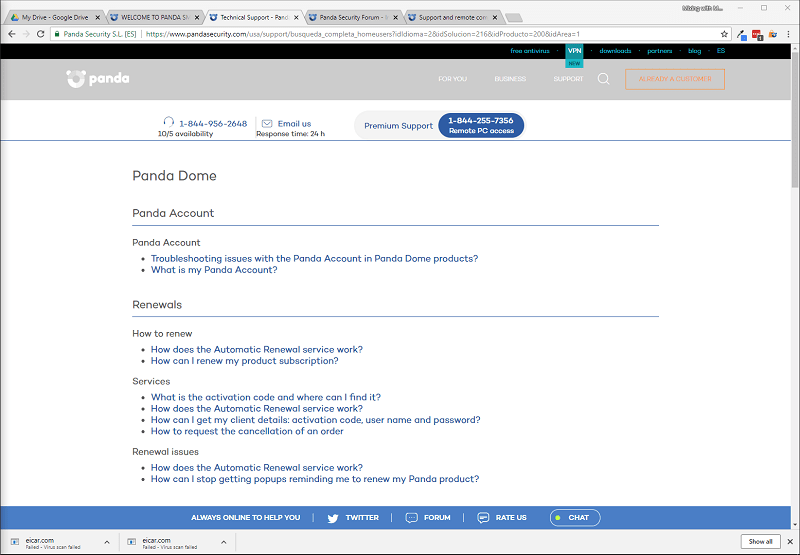
The forum is easy to get through, as well. The look is dated, but Panda splits up topics by product, so you should find what you’re looking for quickly. The forums aren’t that active, though, with the most active topic centered on Panda Free.
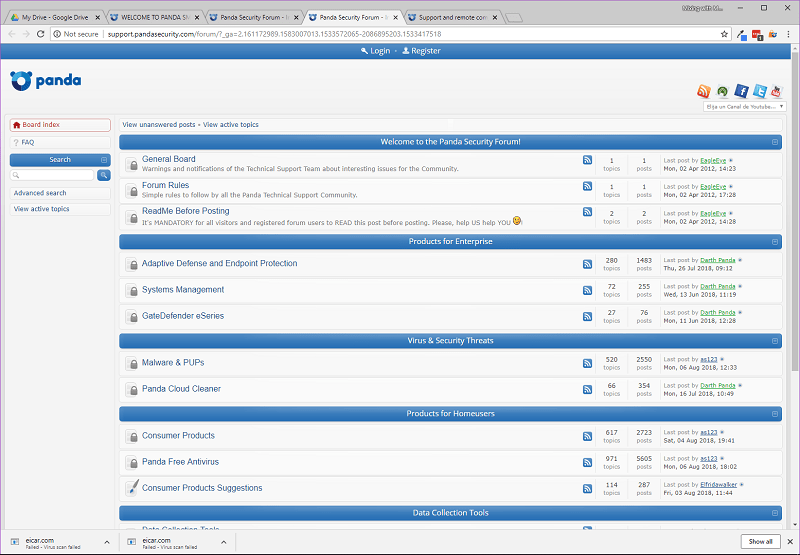
Panda expects an average response time to email inquiries of 24 hours and, when we reached out, it got back to us in under a day as promised. Live chat is available at points, as well, but Panda isn’t clear on the operating hours.
Phone support runs Monday to Friday from 9 a.m. to 6 p.m. in your local timezone. For 24/7 support, the company offers a premium package. It’s $5.88 as long as you pay for a year up front and comes with machine diagnosis and virus removal.
We like the knowledgebase and multiple forms of contact, but the forum could use work. It’s usable, but not active, meaning you’re unlikely to find solid support.
The Verdict
Panda Security is an expensive antivirus that comes with a feature set to match the price tag. That glitz doesn’t hold substance, though, with a mediocre VPN and password manager offering. The same holds true for the interface, which stumbles when you apply pressure.
Despite those shortcomings, Panda is rated as one of the most secure antiviruses on the market. As long as you can get through the clunky user experience and price tag, you’ll be protected.
Panda offers a one-month free trial, which we recommend you download and test yourself. A lot of the experience comes down to personal preference.
Let us know if you’ve used Panda Security in the comments below and, as always, thanks for reading.


